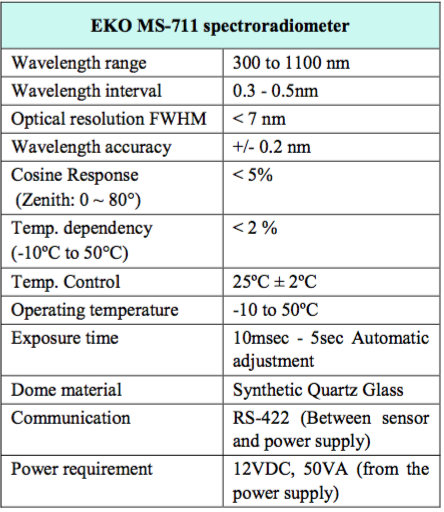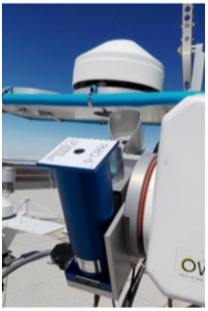The radiation programme, and specifically the implementation of its core component, the Baseline Surface Radiation Network (BSRN) programme, has been performed in close collaboration with the University of Valladolid Atmospheric Optics Group.
Main Scientific Goals
The main scientific goals of this programme are:
- To conduct high quality measurement of radiation parameters.
- To investigate the variations of the solar radiation balance and other solar energy parameters in the three radiation stations managed by the IARC.
- To investigate aerosols radiative forcing with a particular focus on the role played by dust taking advantage of the privileged situation of the Canary Islands to analyse dust outbreaks over the North Atlantic and the unique local radiation network with stations at different altitudes (from sea level to 3555 m a.s.l.).
- To recover, digitize and analyse historical radiation data in order to reconstruct long-term radiation series that allow us to make precise studies concerning sky darkening and brightening, and relate radiation to cloud cover and solar flux.
- To conduct the spectral characterization of the solar radiation: impacts of different types of clouds, aerosols, especially mineral dust, and precipitable water vapour.
Measurement Programme
Direct radiation records from an Abbot silver-disk pyrheliometer are available since 1916, although this information has not yet been analysed. Global solar radiation records from a bimetallic pyranograph are available both in bands and as daily integrated values in printed lists, since 1977. This information has been digitized, recalibrated and processed. The results show an excellent agreement between the bimetallic pyranograph and the BSRN CM21 pyranometer, which allowed the successful reconstruction of a long-term global radiation data series (since 1977), after a careful analysis of historical data (Figure 10.1).
Global and direct radiation measurements started in 1992 as part of a solar radiation project of the Canary Islands Government. In 2005, IZO joined the Spanish radiation network managed by the AEMET National Radiation Center (CNR). Since 2009, IZO has been a BSRN station providing the basic set of radiation parameters. In addition, other parameters, including shortwave and long wave upward radiation, UV-A and UV-B radiation are also measured within the BSRN Programme. Later, some basic radiation measurements were implemented at the other three IARC measurement stations (SCO, TPO and BTO).
Radiation measurements are tested against physically possible and globally extremely rare limits, as defined and used in the BSRN recommended data quality control. Shortwave downward radiation (SDR) measurements are compared daily with SDR simulations, which are modelled with the LibRadtran model. This information has been implemented and shared in the web page http://bsrn.aemet.es/, where real time measurements of global, direct, diffuse and UV-B radiation are shown.
Measurements of spectral direct solar radiation (spectral direct normal irradiance) performed with an EKO MS-711 spectroradiometer (Fig. 10.2) started in 2016. This instrument covers a wavelength range from 300 to 1100 nm, exhibiting a Full Width at Half Maximum < 7 nm. It is equipped with its own built-in entrance optics, and the housing is temperature-stabilized at 25°±5°.
The main specifications of the EKO MS-711 :

The EKO MS-711 spectroradiometer has been mounted on an Owel INTRA 3 sun-tracker, an intelligent tracker which combines the advantages of automatic- tracking operation (automatic alignment with the system of astronomical coordinates follows after a few days), and actively-controlled tracking (a 4-quadrant sun sensor). It is constructed for use under extreme weather conditions; its operational temperature range is between -20 and +50 °C.
![]()
The EKO MS-711 spectroradiometer installed at
IZO.
Details of IARC radiation measurement programme:

Description of the Baseline Surface Radiation Network (BSRN) station at the Izaña Observatory (2009-2017)
A description of the Baseline Surface Radiation Network station at the Izaña Observatory, the measurements conducted and the quality control/assurance procedures carried out was published by García et al. (2019).
Izaña Observatory has been part of the BSRN since 2009. The location of the Izaña station on a global map of all BSRN stations is shown here, alongwith views of the station.

Location of the Izaña station (IZA) on a global map of all BSRN stations http://bsrn.awi.de). Views of Izaña radiation station: (b) Northern and Eastern Views (Azimuth 360°, Inclination 0° degrees; Azimuth 90°, Inclination 0° respectively) (c) Southern and Western Views (Azimuth 180°, Inclination 0° and Azimuth 270°, Inclination 0°, respectively).
Izaña Observatory contributes with basic-BSRN radiation measurements, such as, global shortwave radiation (SWD), direct radiation (DIR), diffuse radiation (DIF) and longwave downward radiation (LWD) and extended-BSRN measurements, including ultraviolet ranges (UV-A and UV- B), shortwave upward radiation (SWU) and longwave upward radiation (LWU) and other ancillary measurements, such as vertical profiles of temperature, humidity and wind obtained from radiosonde (WMO, station #60018) and total column ozone from Brewer spectrophotometer.
The Izaña Observatory measurements present high quality standards since more than 98 % of the data are within the limits recommended by the BSRN. There is an excellent agreement in the comparison between SWD, DIR and DIF (instantaneous and daily) measurements with simulations obtained with the LibRadtran radiative transfer model. The root mean square error (RMSE) for SWD is 2.28 % for instantaneous values and 1.58 % for daily values, while the RMSE for DIR is 2.00 % for instantaneous values and 2.07 % for daily values. Izaña Observatory is a unique station that provides very accurate solar radiation data in very contrasting scenarios: most of the time under pristine sky conditions, and periodically under the effects of the Saharan Air Layer characterized by a high content of mineral dust.
Participation in Scientific Projects and Campaigns/Experiments
Calibration campaign of BSRN instruments with a PMO6 Absolute Cavity Pyrheliometer
As part of the radiation quality assurance system a calibration campaign of BSRN pyranometers and pyrheliometer was performed during summers 2017 and 2018 using an Absolute Cavity Pyrheliometer PMO6 as reference. The PMO6 was calibrated in the World Radiation Center, Davos. The BSRN instruments were calibrated following the ISO 9059:1990 (E) and ISO 9846:1993(E), delivering the corresponding official calibration certificates.

Absolute cavity radiometer (PMO6) installed at IZO during summers 2017 and 2018 in the BSRN sun-tracker.
Future activities
The main on-going and future activities of the radiation programme are focused on:
- Aerosol retrievals from spectral direct irradiance measured with the EKO MS-711 spectroradiometer. Corrections of the field of view.
- Water vapour and column ozone retrieval using the EKO MS-711 spectroradiometer.
- Reconstruction and accurate analysis of a new long- term GSR data series (since 1916) in which newly recovered observation data are being incorporated. Long-term records of aerosols (AOD), cloudiness, and solar flux will be compared with GSR data.
- Accurate determination of cloud attenuation impact on global radiation using GSR from SCO and BTO.
- Accurate analysis of UV-B broadband data from the vertical transect formed by SCO (52 m a.s.l.), IZO (2373 m a.s.l) and TPO (3555 m a.s.l.) observatories, with complementary information on cloudiness, AOD and O3 vertical profiles (ECC O3 sondes).
References
Egli, L., Gröbner, J., Hülsen, G., Bachmann, L., Blumthaler, M., Dubard, J., Khazova, M., Kift, R., Hoogendijk, K., Serrano, A., Smedley, A., and Vilaplana, J.-M.: Quality assessment of solar UV irradiance measured with array spectroradiometers, Atmos. Meas. Tech., 9, 1553-1567, doi:10.5194/amt-9-1553-2016, 2016.
García, R. D., Cuevas, E., García, O. E., Cachorro, V. E., Pallé, P., Bustos, J. J., Romero-Campos, P. M., and de Frutos, A. M.: Reconstruction of global solar radiation time series from 1933 to 2013 at the Izaña Atmospheric Observatory, Atmos. Meas. Tech., 7, 3139-3150, doi:10.5194/amt-7-3139-2014, 2014.
García, R. D., Cuevas, E., García, O. E., Ramón, R., Romero- Campos, P. M., de Ory, F., Cachorro, V. E., and de Frutos, A.: Compatibility of different measurement techniques. Long-term global solar radiation observations at Izaña Observatory, Atmos. Meas. Tech., 10, 731-743, doi:10.5194/amt-10-731- 2017, 2017.
García, R. D., Barreto, A., Cuevas, E., Gröbner, J., García, O. E., Gómez-Peláez, A., Romero-Campos, P. M., Redondas, A., Cachorro, V. E., and Ramos, R.: Comparison of observed and modeled cloud-free longwave downward radiation (2010– 2016) at the high mountain BSRN Izaña station, Geosci. Model Dev., 11, 2139-2152, https://doi.org/10.5194/gmd-11-2139- 2018, 2018.
García, R. D., Cuevas, E., Ramos, R., Cachorro, V. E., Redondas, A., and Moreno-Ruiz, J. A.: Description of the Baseline Surface Radiation Network (BSRN) station at the Izaña Observatory (2009–2017): measurements and quality control/assurance procedures, Geosci. Instrum. Method. Data Syst., 8, 77-96, https://doi.org/10.5194/gi-8-77-2019, 2019.
Staff
Dr Emilio Cuevas (AEMET; Head of programme)
Dr Rosa García (AIR LIQUIDE/UVA; Co-PI)
Ramón Ramos (AEMET; Head of Infrastructure)
Dr Omaira García (AEMET; Research Scientist)
Pedro Miguel Romero (AEMET; Research Scientist)
Dr Fernando de Ory (AEMET; Meteorological Observer- GAW Technician) left IARC in October 2018
Dr Victoria Cachorro (University of Valladolid; Head of Atmospheric Optics Group)
Dr Ángel de Frutos (University of Valladolid Atmospheric Optics Group; Research Scientist)
